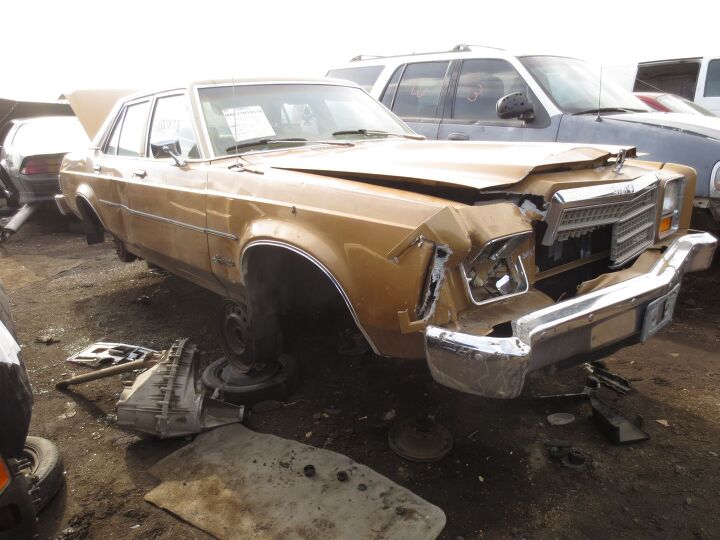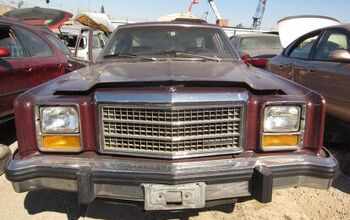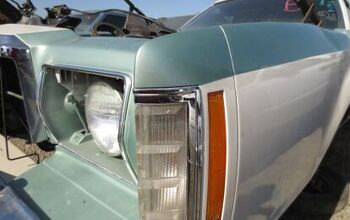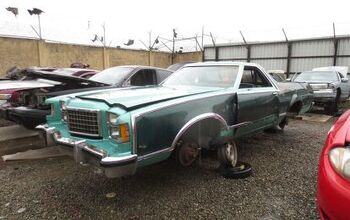Junkyard Find: 1979 Ford Granada Sedan

I took my first driver’s test, in 1982, in a loathsome ex-rental-car 1979 Ford Granada sedan, a car that made my beige 1969 Toyota Corona sedan seem both fun to drive and cool by comparison. Since that time, it makes me happy each time I see a pre-Fox Platform Granada (or its Mercury sibling, the Monarch) in the junkyard. Where it belongs.
The Granada was Ford’s final squeezing of revenue from the basic chassis design used in its compact and midsize cars starting in the 1960s, and so a lot of the Granada’s components will fit older Fords. The front disc brakes from these cars will bolt onto 1960s Mustangs, so they’re gone from this one. However, there is very little interest in an emissions-emasculated, early-1960s-technology 250-cubic-inch straight-six pushrod engine, so this one is reasonably certain to go to The Crusher with the rest of the car.
The sight of this hood ornament, and the vague-yet-parts-bendy feel of the automatic column shifter, were burned into my formative driving brain at age 16, and will remain there forever.
I keep thinking I have photographed quite a few of these cars in junkyards, but prior to today we’d seen just this ’77 Granada Ghia sedan and this ’79 Granada sedan. Ford produced some two door, first-generation Granadas, but few bought them.
It’s just like the Mercedes-Benz 450SLC, but only about one-sixth the price!
The Fox-based Granadas of 1981-1982 were much, much better than the 1975-1980 Granadas. The Taurus, introduced for the 1986 model year, was like a futuristic intergalactic spaceship next to the standard midsize Ford of just six years earlier.

Murilee Martin is the pen name of Phil Greden, a writer who has lived in Minnesota, California, Georgia and (now) Colorado. He has toiled at copywriting, technical writing, junkmail writing, fiction writing and now automotive writing. He has owned many terrible vehicles and some good ones. He spends a great deal of time in self-service junkyards. These days, he writes for publications including Autoweek, Autoblog, Hagerty, The Truth About Cars and Capital One.
More by Murilee Martin
Latest Car Reviews
Read moreLatest Product Reviews
Read moreRecent Comments
- MaintenanceCosts Nobody here seems to acknowledge that there are multiple use cases for cars.Some people spend all their time driving all over the country and need every mile and minute of time savings. ICE cars are better for them right now.Some people only drive locally and fly when they travel. For them, there's probably a range number that works, and they don't really need more. For the uses for which we use our EV, that would be around 150 miles. The other thing about a low range requirement is it can make 120V charging viable. If you don't drive more than an average of about 40 miles/day, you can probably get enough electrons through a wall outlet. We spent over two years charging our Bolt only through 120V, while our house was getting rebuilt, and never had an issue.Those are extremes. There are all sorts of use cases in between, which probably represent the majority of drivers. For some users, what's needed is more range. But I think for most users, what's needed is better charging. Retrofit apartment garages like Tim's with 240V outlets at every spot. Install more L3 chargers in supermarket parking lots and alongside gas stations. Make chargers that work like Tesla Superchargers as ubiquitous as gas stations, and EV charging will not be an issue for most users.
- MaintenanceCosts I don't have an opinion on whether any one plant unionizing is the right answer, but the employees sure need to have the right to organize. Unions or the credible threat of unionization are the only thing, history has proven, that can keep employers honest. Without it, we've seen over and over, the employers have complete power over the workers and feel free to exploit the workers however they see fit. (And don't tell me "oh, the workers can just leave" - in an oligopolistic industry, working conditions quickly converge, and there's not another employer right around the corner.)
- Kjhkjlhkjhkljh kljhjkhjklhkjh [h3]Wake me up when it is a 1989 635Csi with a M88/3[/h3]
- BrandX "I can charge using the 240V outlets, sure, but it’s slow."No it's not. That's what all home chargers use - 240V.
- Jalop1991 does the odometer represent itself in an analog fashion? Will the numbers roll slowly and stop wherever, or do they just blink to the next number like any old boring modern car?












































Comments
Join the conversation
Poor Granada gets no love. For the time these were fairly attractive cars. Certainly more so than FoMoCo's midsize offerings and the barge like LTD/Marquis. They were a solid choice for someone looking to to downsize from those offerings and still stay in a Ford. They always looked more expensive than the appliance-like Fairmont/Zephyr. Sure you would have to be brain dead to order it with a 6, but the V8's motivated it well enough for the time.
Oh, one more fact about the Granada. The Granada based Lincoln Versailles used a 9 inch rear with disc brakes. That rear unit will bolt right into early Mustangs/Falcons, and for years was the only practical way to get a rear disc set-up on a first-gen Mustang.